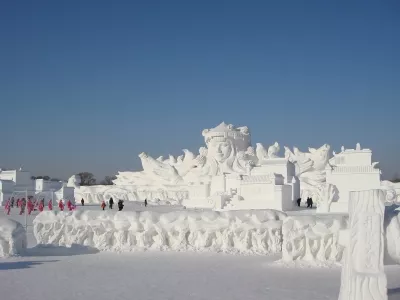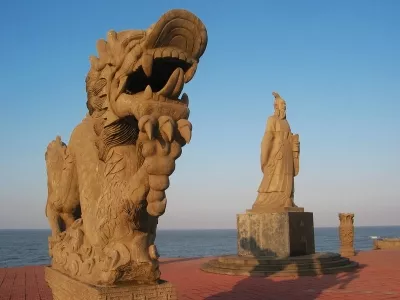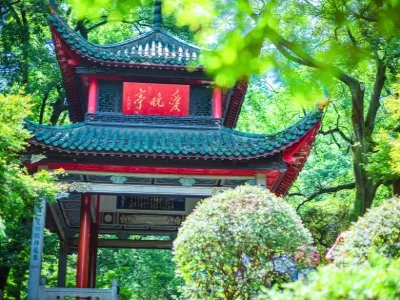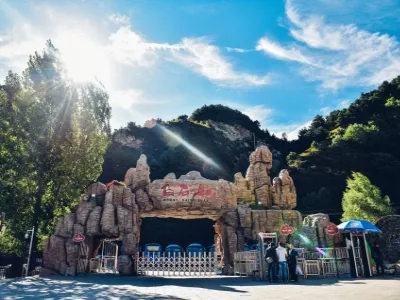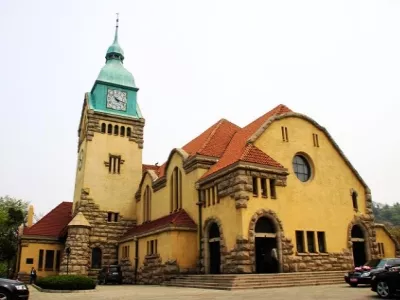Nestled on the northern frontier of Inner Mongolia lies the city of Baotou, whose name in Mongolian means “place with deer”. Baotou earned its moniker as the grasslands surrounding the city have long provided prime habitat for deer and other wildlife. As the largest city in Inner Mongolia, Baotou has grown into an important industrial and commercial hub while retaining its nomadic roots.
Baotou’s strategic position has shaped its history and culture. Situated between Mongolian pastoral lands to the north and the Yellow River basin to the south, it became a meeting point for nomadic and agricultural societies. For centuries, Han Chinese merchants traveled from Shanxi through the western passes to trade in Baotou. This influx of people from central China led to a blending of nomadic and agricultural lifestyles.
Visitors can still experience this cultural fusion today. From cuisine to customs, Baotou offers an authentic taste of northern China. Sitting in a cozy yurt sipping mutton soup and eating flatbreads is a memorable way to embrace Mongolian hospitality. Many neighborhoods feature traditional Han Chinese architecture amid newer cityscapes.
Just outside the city, the grasslands remain home to nomadic herders. Visitors can meet Mongolian families, watch livestock grazing, and gain insight into a way of life deeply connected to the natural environment. Closer to town, relics like the Wudangzhao Monastery and Tombs of Genghis Khan’s Relatives reveal Baotou’s role in Mongol history.
Within the city, industrial muscle now powers Baotou’s economy. It produces iron, steel, machinery, textiles, petrochemicals and more. Yet pockets of greenery remain, like the Darhan Muminggan Wetlands where rare red-crowned cranes breed. For natural scenery, head to the dense Bayan Obo forest, the Baiyunebo Natural Reserve, or the lakes and grasslands of nearby Mount Dalai.
Blending old and new, grasslands and industry, Mongolian culture and Han Chinese influences, Baotou offers the chance to immerse in the fabric of northern Chinese life. From historic sites to scenic parks, cuisine to customs, Baotou provides a window into a frontier region where nomadic and agricultural worlds intermix. For travelers seeking the rich diversity of China, Baotou warrants a spot on any itinerary.
Ride a horse and whip in the center of the city
Escape the urban jungle without leaving the city at Baotou's Saikhan Talara Ecological Park, home to the nation's largest prairie within city limits. As soon as you enter the vast expanse of this natural grassland, you'll feel worlds away from the hustle and bustle. With vivid green grasses and wildflowers stretching as far as the eye can see under boundless blue skies, this pastoral haven offers a taste of life on the Mongolian steppe. Saddle up your trusty steed and gallop freely through the verdant meadows, the floral prairie scents mingling with fresh breezes against your face. Leaving all traces of the modern world behind, it's hard to believe this countryside oasis lies at the heart of Baotou City. Saikhan Talara lets urbanites recharge and reconnect with nature without venturing far off the beaten path. So escaped the congestion, take a deep breath of prairie air, and enjoy a moment of open freedom on horseback.
Rolling yellow sand, once in a millennium desert
Just 60km outside Baotou City lies Xiangshawan Desert, where millennia of winds have sculpted ever-shifting seas of sand. As you journey into its vast expanse, prepare for a visual spectacle to shock your senses. Endless rippling dunes extend as far as the eye can see, dwarfing all in their presence. Words fail before nature’s humbling display. Yet enter the desert respectfully, for this domain belongs to the sands. Book a 4WD safari tour to traverse these ancient vistas, cresting and diving down waves of golden hills. As plumes of dust trail behind, peer into the hazy horizon, imagining vanished kingdoms now buried below. When the setting sun casts its blazing glow, the desert's beauty astounds. From towering pyramids to smoothest contours, Xiangshawan’s elemental landscape changes yet endures over eons. Lose yourself in the pulse of this living desert, eternal in its scale. Return renewed, knowing you’ve witnessed the true face of time.
Beautiful Wudanggou, hidden in the ethereal ancient temple
Nestled within the tranquil mountain valley of Wudang Gou ("Willow Tree Valley" in Mongolian) lies the timeless Wudang Lamasery. This eminent Buddhist monastery is one of China's four largest Tibetan lamaseries, its orderly white walls and expansive grounds whispering centuries of wisdom. Beneath bright blue skies, flanked by verdant trees, this spiritual sanctuary resides in harmony with nature's beauty. As sunlight filters through the leaves, one can feel the lamasery's calming aura - a peaceful refuge far removed from worldly cares. Since its founding in 1727, the devout have made pilgrimages to worship within its hallowed halls. Today, the temple continues its noble traditions, from ringing morning bells to twilight chanting. Visit Wudang to experience this living piece of history, unchanged through generations. Let its meditative stillness wash over you, a refreshing balm for modern minds. Find tranquility in the present moment, as past and future fade away.
Eating meat in large chunks, drinking wine in large bowls, and hooking people's souls with naked oats and mutton
The Inner Mongolians are known for their outgoing, hospitable nature. Visiting Baotou, you must partake in their joy of feasting! Savor aromatic airag, fermented mare's milk, from elegant silver bowls. Juicy chunks of lamb kebabs fill the air with meaty fragrance. Wash it all down with Chinese wheat noodles swimming in savory mutton broth. Just out of the boiling vat, the buckwheat noodles soak up every bit of flavor. Each hearty bite encapsulates Baotou's culinary fusion - Mongolian robustness meets Shanxi refinement. With generous portions and rich tastes, dining here satisfies on every level. The local hospitality means your drink will stay full as you swap stories and cheers over hearty fare. For a quintessential Baotou experience, gather around a table piled high with steamed buns, skewered meats, and fresh noodles. Then dive in with gusto to this hearty feast!
Best Travel Time
Baotou belongs to a semi-arid temperate continental monsoon climate, with an average annual temperature of 8.5 ℃, an annual minimum temperature of -27.6 ℃, and an annual maximum temperature of 35.5 ℃. Summer and autumn (mid to late June to early September) are definitely the best time to travel to Baotou. At this time, Baotou has a refreshing breeze, beautiful flowers, abundant fruits and vegetables, making it an ideal summer resort. Spring is not only cold but also prone to sandstorms, making it unsuitable for outings; In winter, the temperature is very low. At that time, Baotou will be covered in ice and snow, wrapped in silver, with unique northern characteristics. If you are not afraid of the harsh cold in Inner Mongolia, you can also come here to enjoy the pure ice and snow world.Dressing Guidelines
Hohhot is a famous border city with over 400 years of history and distinct ethnic characteristics alongside numerous historic sites and attractions. It has over 50 temples of various styles. Picturesque grasslands dot the suburbs, dotted with sheep and cattle, filled with birdsong and fragrant flowers. To the south bank of the Dahei River lies the ancient Western Han Dynasty tomb of Wang Zhaojun, towering like a green hill.
Lake Harsu, known as the "Lake Beyond the Great Wall", is a natural scenic lake with crystal blue waters under sunny skies. Connected to the Mongolian Quarter is the Islamic Quarter done in desert yellows with alternating greens and whites. Rounded domes and towering minarets evoke rich Islamic culture and architecture. From temples to tombs, grasslands to lakes, Hohhot allows visitors to experience the diverse history and culture of northern China.
Self driving
Driving to Baotou from major cities like Beijing, Tianjin or Yinchuan is a good option for road trippers. The drive from Beijing to Baotou covers about 600 km (370 miles) and takes around 7-8 hours. From Tianjin, the 700+ km (430+ mile) drive takes a similar amount of time. The trip from Yinchuan to Baotou is around 550 km (340 miles) and can be completed in 6 hours.
Travelers coming from or passing through Shaanxi Province can start in Yulin, which is about 300 km (185 miles) and a 4+ hour drive from Baotou.
Since Beijing is a major transportation hub with connections across China, here is a driving route from Beijing to Baotou:
Beijing - Baotou Driving Route
From Beijing, take the Jingzang Expressway, passing through Zhangjiakou, Jining, and Hohhot before arriving in Baotou. Note: at Zhangjiakou/Xuanhua, do not turn onto XuanDa Expressway towards Datong; continue following signs for Xuanzhang.
Estimated Tolls: ¥250
Estimated Fuel Cost: At 8L/100km fuel consumption and 700 km distance, need ~56L of gas. At ¥8.3/L, total fuel cost is ~¥465.
With expressways connecting major cities in northern China, Baotou's ancient sites and natural landscapes can be conveniently reached on a rewarding driving tour.





